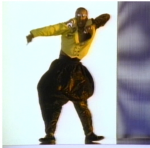When I was in middle school growing up in New Jersey, I convinced my mother to take me to a trendy clothing store called Trenton Joe’s where I could buy the hottest fashions for the coolest 12-year-olds.
She bought me a pair of gray parachute pants and black shirt with one gray and one red stripe across the

I went to school the next day and my friend Dominic, who was accustomed to seeing me in my standard uniform of blue jeans and a baseball t-shirt, looked at my pants and said, “Nice Hefty bags.”
I remember perspiring profusely that day, wondering if everyone was looking at me and my Hefty bag pants. I went home, put the trendy clothes away, and didn’t wear them anymore.
* * *
A couple days ago, I recommended seeing the film Finding Joe, which offers profound insights on how to live a life of inspiration and joy. Today, I want to suggest another piece of media: This American Life’s latest episode, which is titled “Middle School.” It’s brilliant, and will make listeners think hard about whether there is a better way to educate kids of that age.
The segment starts with host Ira Glass interviewing a 14-year-old named Annie, who wrote to him suggesting that he do a show about the middle school years. In her initial email, she signed it “anonymous.” When asked why she didn’t sign her name at first, Annie replies, “In middle school, everyone is so judgmental. I didn’t want other kids to judge me if they heard me on the radio.”
Later, she says, “Kids there are in socially awkward stages that the drama every day can be frustrating. . . . No matter who you are or what you do, you’ll get made fun of for it. Anything, anything in the world you can get made fun of for.”
Finally, “If I got a new sweater, say, for Christmas that I really liked and that I really wanted to wear it to school, I’d be really nervous because, what if someone didn’t like my sweater or someone made fun of me for wearing it? It can be hard to do even the smallest things because people will tease you for it or judge you for it.”
Later in the show, a reporter is interviewing a boy who is preparing to enter a dance at his middle school. He asks the boy, “What are you hoping happens at this dance?”
The boy says, simply, “I’m hoping nothing bad happens. Like, no humiliation or something that will be a story for the next month or two.”
* * *
That’s really what it comes to down to for students in the middle school years (and, not just those in the middle school years). At the thinktank All Kinds of Minds, the saying goes, “The highest priority of a student is to avoid humiliation at all costs.”
And yet, in traditional schools, the highest priority is not the emotional safety of the students. We sit kids in rows and teach them all about Washington State history or drill them in fractions, decimals and percents, then hold public meetings about how to raise test scores. Meanwhile, untold number of kids sit in those rows wondering if everyone was looking at them, wondering if they’re going to say the wrong thing, something that will be a story for the next month or two.
If you want kids to learn, the first step is to create an environment in which they are free to be themselves, in which they can feel safe in knowing they’re not at risk for facing humiliation. In that context, teaching and learning academic material is so much easier.
(And they’re much more open to seeing for themselves a life of inspiration and joy!)
(Join the discussion at www.facebook.com/reeducate. Get updates at www.twitter.com/reeducate.)
